Is Dinelson Lamet the San Diego Padres ace?

Mandatory Credit: Sergio Estrada-USA TODAY Sports
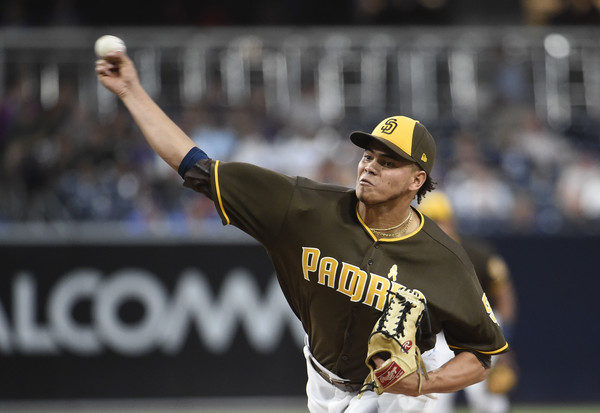
With a clean bill of health, is Dinelson Lamet the San Diego Padres ace?
Chris Paddack, MacKenzie Gore, Garrett Richards. Those are just a few San Diego Padres’ pitchers that Dinelson Lamet is going to outperform in 2020.
Okay. That was (kind of) a joke. But what if it wasn’t? These next 1,356 words will be dedicated to explaining why that is very much a possibility, even if it isn’t necessarily the most likely outcome.
Dinelson Lamet – Version 1.0
Lamet was always going to be a guy that racked up a lot of strikeouts. He put up big K numbers through the minors, and though he’s never been a control artisan, his walk rates were never high enough to be terribly concerning. As mainly a two-pitch* guy, he appeared destined for the bullpen so that his nasty fastball/slider combo could play up, but he had enough success as a starter that he was never relegated to pen.
*Yes, he throws a four-seam fastball and also a sinking fastball, but that’s not really that important, and his sinker has been absolutely crushed so he should probably just scrap it altogether.
Lamet made his MLB debut back in 2017 with the Padres. He was an average-ish pitcher over 114.1 innings with a 4.57 ERA/4.35 FIP/4.20 xFIP, which was good for 1.4 fWAR. That’s not great, but it’s good enough to at least hang around as a back-end major league starter. The upside was there in 2017, as his 28.7 K% was excellent (MLB average is around 21.7%), but his walk rate was nearly 3% above league average, and he severely struggled when facing hitters the third time through the order, as two-pitch starters tend to do. Nonetheless, Lamet was primed for another starting gig in 2018 when he started having elbow problems towards the end of spring training. Shortly after that, he became yet another Tommy John victim. By the start of the 2019 season, he was all but forgotten by many Padres fans.
Dinelson Lamet – Version 2.0
On July 4th, 2019, Lamet finally made it back to the majors. But this time, he was different. The results weren’t all that different – he did lower his ERA from 2017 by 0.5, but that’s not the point here – he was a different pitcher. His slider never had a very consistent movement profile, to begin with, but it became clear that he was actually throwing two different breaking balls now. We’ll call the new pitch a curve just for clarity, but it’s really just another slider with a different shape.
This is where it gets interesting. Lamet’s “actual” slider was now much tighter, getting less horizontal and vertical movement – almost more like a cutter. His new curve was getting a ton of horizontal movement but didn’t have nearly as much vertical movement as an average curveball, so it looked a lot like his slider coming out of his hand. This graph does a much better job of describing this than I do (the slider and curveball are on the right side of the graph):
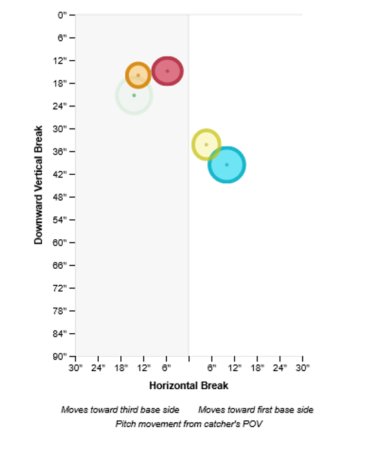
A lot is going on here. To make it simple, ignore everything except the slider (yellow) and the curveball (blue) since that’s what we’re focused on. The movement profiles seem to show that Lamet is basically using his slider as two different pitches. The “slider” has less movement, while the “curveball” has a much sharper break. If you wanted to say that Lamet is just varying his slider so much that it’s actually being classified as two different pitches, that might not be entirely inaccurate. The thing that makes this special is that he throws them both at roughly the same speed despite the different shape of the pitches, which is extremely deceiving for hitters. That is what allowed him to generate an absolutely ridiculous 49.3% whiff rate on breaking balls (it was 39.6% in 2017), and it’s also why you should be buying all of his stock in 2020. You may be thinking, “yeah, but most pitchers get more whiffs on breaking balls,” and you would be correct. But most pitchers don’t get nearly as many whiffs on breaking balls as Lamet did in 2019 for the Padres. To put it in perspective, Lamet’s whiff rate on breaking balls in 2019 was better than Aroldis Chapman and Josh Hader. That’s a fun sentence to write.
To give you an even better idea of the difference between these two pitches, let’s see them in action:
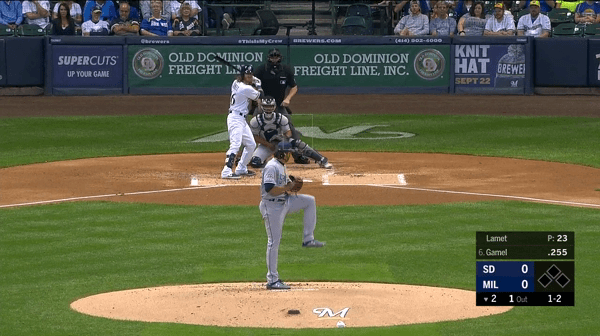
This is an 88 mph slider to strike out Ben Gamel. As you can see, it’s thrown hard and has tight, horizontal movement but not a ton of vertical break. Let’s compare that to this curveball used to strike out Mike Moustakas in the same game:
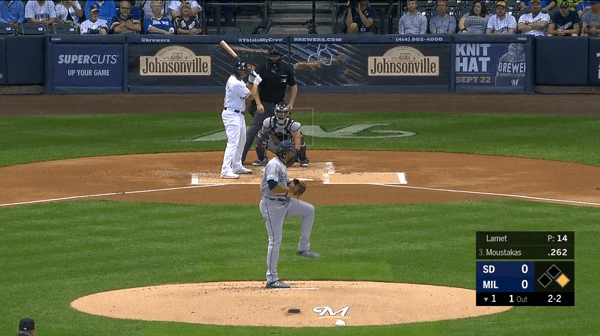
This pitch is also thrown at 88 mph, but it has an entirely different shape than the slider thrown to Ben Gamel above. It has much more movement, both horizontally and vertically. This variation in breaking balls is what allowed Lamet to carry a much higher whiff% in 2019 than he did in 2017.
So, will he be even better in 2020?
Projections for Lamet vary considerably, and a lot of that has to do with how many innings he pitches. Before we get into this, it’s critical to recognize that projections are essentially just median outcomes, meaning they don’t tell us anything about a player’s floor or ceiling. So, when we see Steamer project, Bryce Harper, for 4.3 fWAR and Freddie Freeman for 4.2 fWAR, that only tells us what the projection system believes is the most likely outcome. It doesn’t tell us that Harper’s ceiling is much higher (it is) and that Freeman has a much higher floor (he does), it only tells us that they have roughly the same median outcome. With that said, Steamer likes Lamet quite a bit, projecting him for 3.3 fWAR over 162 innings. ZiPS is less optimistic, projecting him for 1.3 fWAR over 110 innings.
|
Dinelson Lamet 2019 Result vs 2020 Projections Source: Fangraphs |
|||
| Lamet’s 2019 stats | Steamer 2020 projection | ZiPS 2020 projection | |
| Innings pitched | 73.0 | 162.0 | 110.0 |
| ERA | 4.07 | 3.75 | 4.09 |
| K% | 33.6 | 29.9 | 29.1 |
| BB% | 9.6 | 9.4 | 11.2 |
| HR/9 | 1.48 | 1.2 | 1.2 |
| fWAR | 1.3 | 3.3 | 1.3 |
Both projection systems buy into Lamet’s elite strikeout percentage, even if they project it to be a bit more modest than last year. One important thing you’ll notice is that both projection systems have Lamet’s HR rate decreasing considerably from 2019. That’s important because the long ball really hurt him last year. Check out his 2017 and 2019 HR/FB% compared to league average:
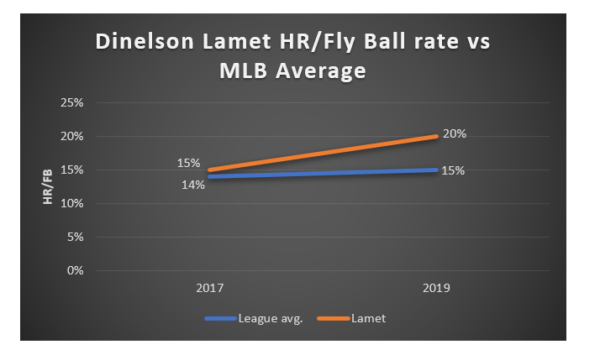
Lamet improved his ERA by a half-run in 2019 despite a 5% increase in HR/FB rate, which is a lot even after accounting for the impact of the 2019 juiced ball. HR rate is particularly important for a fly-ball pitcher like Lamet, and the HR rate also tends to gravitate towards league-average for the most part. All that really means is that even if he doesn’t do anything differently in 2020, he’ll probably allow fewer runs just because his HR rate should regress closer to league-average. This is why Lamet’s FIP was 3.91 in 2019, while his xFIP was much better at 3.44. For those unfamiliar, Fielding Independent Pitching (FIP) is basically what a pitcher’s ERA should be if you only look at the outcomes that the pitcher can control by himself (strikeouts, walks, hit batsmen, and home runs). It’s a great way to evaluate and pitcher who has, say, a REALLY bad infield defense (looking at you, 2019 Padres) that doesn’t help him out with run prevention. Expected Fielding Independent Pitching (xFIP) is the same thing, but with a normalized HR rate under the premise that pitchers can limit the number of fly balls they allow, but they cannot limit how many of those fly balls become home runs. So, according to xFIP, Lamet should’ve been even better in 2019 than he was by FIP – that is a very good thing for his 2020 outlook.
All of this is really to say that Lamet’s success in 2019 does not appear to be a fluke. In fact, he probably should’ve had better results than he actually did, and the way he’s doing it seems to be reasonably sustainable. If he stays healthy, and there’s not really any reason to believe he won’t, Lamet has a very high ceiling in 2020.
All stats used in this article are courtesy of Baseball Savant unless otherwise noted.
Holden Phillips is an Occupational Exposure Scientist who also happens to write about baseball, primarily focusing on analytics. He is a huge baseball fan and fell in love with the Padres during his college years when West Coast baseball was often the only baseball on TV after 9pm in the Eastern time zone. Find his work at eastvillagetimes.com and maxsportingstudio.com.
Lamet was an ace in the making back in 2017, before TJ. I specifically remember him doing a job on the Braves, and their manager, Brian Snitker, trying to psych Lamet out by having the umpires check him for “foreign substances”. The umpires seemed to know it was purely theater and made a cursory check, but it had no effect on Lamet, who shrugged it off and kept shutting the Braves down.
Now Lamet is back and his velocity and movement are back with him. He was still a little off in command up to his 14th and final comback start of the year, but should be ready to go after a Spring Training tuneup. He’s not an ace YET, but he’s back on the ace-in-the-making track.
I’ve seen comments that he won’t get to throw 115 pitches in a start, so he’s a 5 IP pitcher. An ace pitches a complete game with 115 pitches, so Lamet with a pitch count in the high 90s should get through the 7th, and that’s enough with the Padres’ stacked bullpen. That’s when you know he’s an ace.
I agree that Lamet has shown great promise – but you don’t anoint a pitcher as your ace until he actually performs at that level. I’m hoping for great things, too, but let’s not get ahead of ourselves!
Lamet and Franchy Cordero are a couple of players that get a lot more love than they seem to deserve based on what they have done at the big league level.
Because the potential is there for them to become great players. Unfortunately injuries have been a big problem for both, let’s see if that changes this year. I’m hoping for the best.